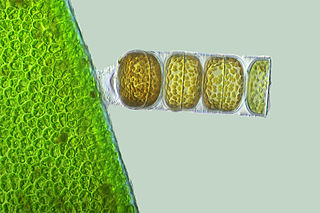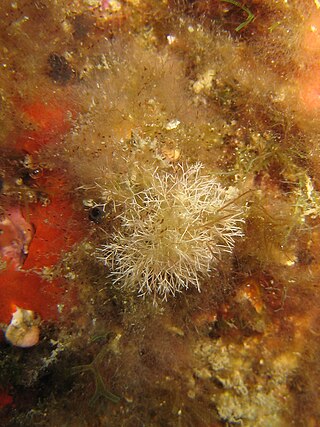
Oscillatoria is a genus of very important sugar making microscopic creatures

Porphyra is a genus of coldwater seaweeds that grow in cold, shallow seawater. More specifically, it belongs to red algae phylum of laver species, comprising approximately 70 species. It grows in the intertidal zone, typically between the upper intertidal zone and the splash zone in cold waters of temperate oceans. In East Asia, it is used to produce the sea vegetable products nori and gim. There are considered to be 60–70 species of Porphyra worldwide and seven around Britain and Ireland, where it has been traditionally used to produce edible sea vegetables on the Irish Sea coast. The species Porphyra purpurea has one of the largest plastid genomes known, with 251 genes.

Chordariaceae is a family of brown algae. Members of this family are may be filamentous, crustose with fused cells at the base, or they may be terete and differentiated into a central medulla and an outer photosynthetic cortex. They have a sporphytic thallus usually aggregated to form a pseudo-parenchyma.

Dictyotales is a large order in the brown algae containing the single family Dictyotaceae. Members of this order generally prefer warmer waters than other brown algae, and are prevalent in tropical and subtropical waters thanks to their many chemical defenses to ward off grazers. They display an isomorphic haplodiploid life cycle and are characterized by vegetative growth through a single apical cell. One genus in this order, Padina, is the only calcareous member of the brown algae.

The Delesseriaceae is a family of about 100 genera of marine red alga.

Rhodomelaceae is estimated to be the largest red algae family, with about 125 genera and over 700 species.

Laurencia is a genus of red algae that grow in temperate and tropical shore areas, in littoral to sublittoral habitats, at depths up to 65 m (213 ft).

Gigartinaceae is a red algae family in the order Gigartinales.

Wrangeliaceae is a red alga family in the order Ceramiales. It was published by J.Agardh in 1851 in his book Species, genera et ordines algarum : seu descriptiones succinctae specierum.

Callithamniaceae is a family of red algae (Rhodophyta) in the order Ceramiales. The family was first described by Friedrich Traugott Kützing in 1843.

Spatoglossum is a marine brown algal genus in the family Dictyotaceae, with a worldwide distribution
Cladosiphon is a genus of brown algae belonging to the family Chordariaceae.

Melosira is a genus of diatoms belonging to the family Melosiraceae.
Balliales is an order of red algae belonging to the class Florideophyceae. The order consists only one family, Balliaceae. with only one genus - BalliaHarvey.

Wrangelia is a genus of red algae in the family Wrangeliaceae.

Liagoraceae is a family of red algae (Rhodophyta) in the order Nemaliales. The type genus is LiagoraJ.V.Lamouroux.













